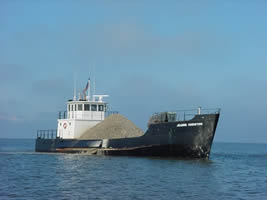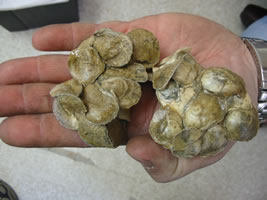|
|
Oyster Reef Enhancement and Restoration
LOCATION: Delaware River and Bay
PURPOSE: To compensate for the loss of bottom habitat in the Delaware Estuary as a result of the Athos oil spill, a three year oyster reef restoration program was funded. Oysters play an important role in the Bay’s ecosystem. They provide habitat for a variety of organisms, which are dependent upon oyster reefs for spawning, foraging and nursing. The project will increase oyster populations as well as provide habitat for other living estuarine resources such as finfish, crabs, shrimp, and snails many of which are a source of food for diving ducks, diving birds, gulls and wading birds.
BACKGROUND: The oyster project builds on an established restoration program that has been underway by the Department since a successful 2003 pilot project that enhanced an oyster seed bed in the Bay with the planting of 30 million oysters. The restoration program was initiated due to the near disappearance of the oyster industry in the early 1990s due to an epizootic oyster parasite known as Dermo, which caused a high rate of mortality in oysters. This parasite does not affect human consumers.
 |
Shells being deposited
in the lower Delaware Bay |
 |
| Oyster spat (larvae) |
PROJECT SUMMARY: Oyster larvae require a clean, hard surface to which they can attach during the oysters’ spawning season. Beginning in June and July, 2011, more than 26,000 bushels (approximately 65 truckloads) of shells were deposited in the lower Delaware Bay, providing a place for the oyster larvae to settle and thus increasing the number of juvenile oysters in the Bay. In late summer-early fall, after the oyster larvae, now known as spat, had settled on the shell, the shell rich with oyster spat were re-harvested, transported up-bay and deposited on the bay bottom at an existing oyster bed with significantly lower natural mortality rates than those in the lower bay. This procedure will be repeated in 2012 and 2013. The monitoring program will take place over a five year period.
BENEFITS: Oysters play an important role in the bay’s ecosystem. They provide habitat for a variety of organisms, which are dependent upon oyster reefs for spawning, foraging and nursing. The project will increase oyster populations as well as provide habitat for other living estuarine resources such as crabs, shrimp, and snails. These organisms in turn are a source of food for diving ducks, diving birds, gulls and wading birds.
PARTNERS: NJDEP, National Oceanic and Atmospheric Administration (NOAA)
|